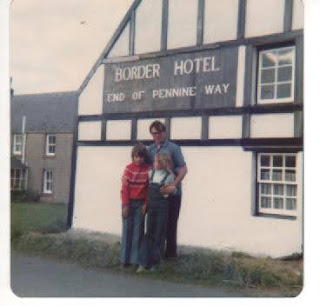Walking The Pennine Way When I Was Eleven: Stage 12 Middleton-in-Teesdale to Dufton
Start: Middleton-in-Teesdale
Finish: Dufton
Distance: 21 miles
Total Distance Walked: 158 miles
If the previous stage had been unmemorable this one was probably the finest of the entire walk. It was the one we had been thinking about for days in the knowledge that it would be long and challenging. Indeed it was, but it was also a lovely walk, mostly along the River Tees, with some fascinating sights on the way.
We left Middleton and almost immediately were by the river walking upstream. The first miles were pleasant but it was only after four miles that we reached the first notable feature, Low Force. This is a group of small waterfalls which together make quite impressive rapids. However, they are just the warm-up act for their big brother High Force, a mile along the Tees. We could hear High Force from well downstream, the roar becoming louder until we could see the high cascade of the most impressive waterfall in England. A few days earlier on the Pennine Way had seen Hardraw Force, the highest waterfall in England, which had the altitude but not the volume of water to be very impressive due to the dry weather. High Force had both even though we still hadn't had any rain. This is one of the great sights of the Pennine Way.
The path took us past the top of the falls and the thundering gradually diminished as we continued upstream. We entered a more tranquil part of the river and left it for a mile to follow Langdon Beck. We talked to some young women who had also set out from Middleton but whereas we were going all the way to Dufton they were stopping at Langdon Beck youth hostel which we now neared.
Returning to the Tees took us to the bottom of a steep escarpment at Falcon Clints. We had to negotiate a boulder field which was painstaking and time-consuming. After a bend in the river we came to the next highlight of the day, Cauldron Snout. This steep cascade doesn't quite qualify as a single waterfall but as the Tees froths furiously down the narrow channel between rocks you can't help stopping to admire it.
Unfortunately it was now late afternoon and we couldn't hang around too long as we still had miles to go. The character of the walk now changed as we headed across moorland away from the river. After a few miles we came to the Maise Beck. Not for the first time we were grateful for the lack of rain as we had to ford the Beck. There was a cable across the beck to hold onto but the water was fast-flowing and had the level been higher we would have had to go an extra mile to reach a bridge and return to the opposite bank.
Even so, it was starting to get dark as we reached the final descent into Dufton. This began at one of the great geographical features of the Pennine Way, High Cup Nick, a magnificent cut in the Pennines with the rock strata clearly visible. I only know this because of descriptions I've read and pictures I've seen because when we walked there it was too dark to appreciate. We were also in a hurry to get down to Dufton before it got fully dark. The path down was quite narrow with a steep slope to the left and occasional streams flowing across.
We reached Dufton after eleven hours walking. It had been a long but interesting day and I was delighted to have got through the hardest day of the walk so far. We stayed at a campsite in the village, of which I can't recall anything. I also don't remember what we had to eat that evening but at one point we were outside the pub, The Stag, where we chatted to the two lads we had seen near Crowden way back on Day Two. They were surprised to see us and said that they thought we had a bucket and spade with us when they saw us back then. It was another boost to realise that we had kept pace with two young lads over ten days on the Pennine Way.


Comments
Post a Comment